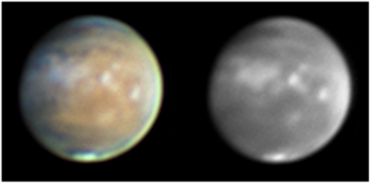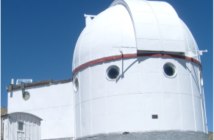After the article, “What can we see on Mars this year” let’s now review some technical advices.
Make images in true colors
The Martian details are quite unequals, between the sharp and contrasted surface details seen in red, and the faint, low-contrast clouds observed in blue light. As the most interesting on Mars is to follow the evolution of meteorological activity, it is important not to use processing that will artificially erase the clouds. Use natural colors.
Take care of the B component, and show it next to the color frame
For the same reason, we should not neglect the B image. Do not hesitate to use a longer video time than for R and G, to use WinJupos derotation techniques, and above all, show the blue image on your final set. We must spot every water-vapor white clouds and only the B component show them all.
Mars with clouds, March 2nd, 2014. Ls = 97°
Indicate the Martian season
This is very important! Usually, amateurs write on their images data like UT date and time, apparent diameter etc. But in comparison with other planets, one ephemeris is crucial for Mars: the Solar Longitude (Ls). Mars is a planet whose activity is largely seasonal, and the Ls informs us where is the planet in this seasonal cycle. The conversion of Ls degrees in season is the following: Ls 0 = northern spring equinox, Ls 90 = northern summer solstice, Ls 180 = southern spring equinox, Ls 270 = southern summer solstice.
Other data can be interesting (Declination of Earth, phase angle) but the Ls is by far the most important to understand what we see on the images.
Image at regular intervals
The Martian meteorological phenomenon evolve by the hour during the day. It’s very interesting to make images with a regular spacing to show this evolution. The ISMO recommends to shoot every 40 minutes (CMO 387), but otherwise every 30 (or even 60 mn) is fine as well.
Below: series of images taken every half and hour on March 19th, 2012 (Ls = 86), revealing the dissipation of morning hazes in Tharsis.



